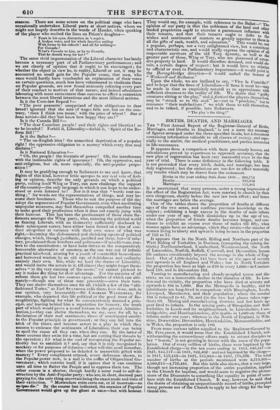BIRTHS, DEATHS, AND MARRIAGES.
THE " First Annual Report of the Registrar-General of Births, Marriages, and Deaths in England," is not a mere dry summary of figures arranged under the three specified heads, but a document containing information valuable to all classes of society, and espe- cially to the statist, the medical practitioner, and parties interested in life-assurances.
It appears from a comparison with facts previously known, and calculations proved by experience to approach accuracy, that the new plan of registration has been very successful even in the first year of trial. There is some deficiency in the following table. It is not pretended that every birth, death, and marriage, has been duly registered ; but the omissions are too few to affect materially any results which may be drawn from the statement. •
Births in the year ending 30th June 1838 39395:,5712
Deaths 335,956 Marriages 111,481 It is ascertained that many persons, under a wrong impression of the effect of the Registration Act, were married in church by their own clergymen, shortly before the new law took effect; and hence the marriages are below the average. One of the tables shows the proportion of deaths at different ages of the two sexes, and confirms previous knowledge on the subject ; exhibiting a large excess in the deaths of male infants under one year of age, which diminishes up to the age of ten, when the proportion of female deaths becomes larger, and con- tinues to exhibit an excess over those of males till fifty, when women again have an advantage, which they retain—the number of women living to ninety and upwards being to men in the proportion of 116 to 75.
It appears that in the North Riding and Northern part of the
West Riding of Yorkshire, in Durham, (excepting the mining dis- trict,) Northumberland, Cumberland, Westmoreland, the North of Lancashire, Norfolk, Suffolk, Cornwall, and Devonshire, human life endures considerably beyond the average in the whole of Eng- land. Out of 1,000 deaths, 145 have been at the ages of seventy and upwards in all England and Wales ; but in North Yorkshire the proportion has been as high as 210 in every 1,000—in Cumber- land 198, and in Devonshire 192.
Turning to manufacturing and closely-peopled towns and dis- tricts, we see a lamentable decline in the duration of life. In Lon- don and its vicinity, the proportion who have died at seventy and upwards is 104 in 1,000. But the Metropolis is healthy, and its inhabitants are long-lived in comparison with Birmingham, Leeds, Liverpool, Manchester, and their population ; where the number
104 is reduced to 81, 79, and (in the two last places taken loge- titer) 63. Mining and manufacturing districts and low lands ap- pear fatal to infants. In the mining parts of Shropshire and Staf- fordshire, in Leeds and its neighbourhood, in Lincolnshire, Cam- bridgeshire, and Huntingdonshire, 270 deaths in 1,000 are those. of infants under one year ; whereas in the North of England, in Wilt- shire, Dorsetshire, Devonshire, Herefordshire, Monmouthshire, and in 11 ales, the proportion is only 180. From sonic curious tables supplied to the Registrar-General by
Mr. FINLAISON, it would seem that the Established Church, not- withstanding the extraordinary efforts made to attract disciples to her "bosom," is not growing in favour with the mass of the popu- lation. Out of every million of births, there were baptized by the Established clergy—in the ten years ending in 1811, 846,547—m 1821, 844,117—in 1831, 822,402: and not bainized by the clergy in 1811, 153,453—in 1821, 155,883—in 1831, 178,598. The total number of births at the periods mentioned were 3,519,301- 3,980,615-4,716,481, But this table also shows, that a very large, though not increasing proportion of the entire population, applied to the Church for baptism, and would seem to negative the preten- sions of the Dissenters to something like equality in point of num- bers with the Established Church. It may, however, be said that the desire of obtaining an unquestionable record of births, prompted many persons not of the Church to apply to her clergy for the bap- tismal rite.
For every 100,000 marriages, the baptisms were—in the decade ending in 1811, 342,534—in 1821, 353,992—in 1831, 353,231. Mr. FINLAISON is at a loss to decide whether the large dimi- nution of baptisms in the last decade, the growth of population being taken into account, indicates irreligious neglect of the rite, or whether it is owing to the gradual influx of Roman Catho- lics, whose children are baptized in their own chapels. But allow- ing for the Irish Roman Catholic immigration, there was a consi- derable addition to English and Protestant births in the period alluded to, and yet no increase of baptisms by the Established clergy : how is this accounted for, except on the supposition that she population has become in a greater degree irreligious or non- conformist ? Mr. FINLATSON calculates, that in May 1841 the total population of England and Wales will be—males, 7,983,652; females, 8.143,910; together, 16,127,562. We reserve some medical statistics, chiefly supplied by Mr. FARR; who seems to have bestowed much time and research on the subject.



























 Previous page
Previous page